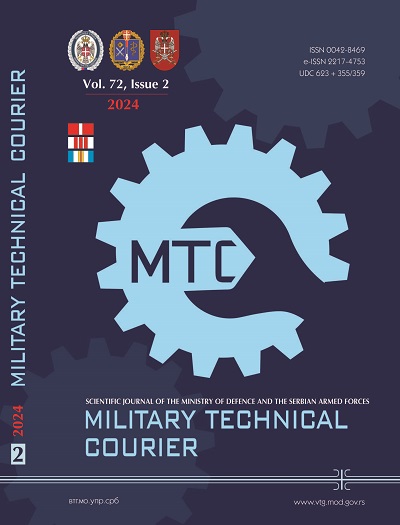Recycling of shredded printed circuit boards (PCBs) by two-phase moving wave conveyors
Abstract
Introduction/purpose: The aim of this study is to demonstrate the viability of electrostatic separation of mixtures from shredded printed circuit boards (PCBs), in association with the X-ray fluorescence analysis, and simultaneously to examine how the efficiency of this method is influenced by the supply voltage, both in terms of amplitude and nature.
Methods: The electrostatic separation technique is used by means of a two-phase moving wave conveyor with characterisation analysis using X-ray fluorescence in order to justify the efficiency of the process studied.
Results: The results of this study can have practical implications for improving the recycling process of electronic waste, especially from printed circuit boards (PCBs). By optimizing the high voltage and understanding its effects on the electrostatic separation process, it may be possible to increase the efficiency and effectiveness of recycling valuable materials from electronic waste while reducing environmental impact.
Conclusion: The XRF analysis of the samples reveals their distinct compositions. The variations observed are even more marked if the influence of the voltages applied on the electrostatic separation process is considered.
References
Ghosh, B., Ghosh, M.K., Parhi, P., Mukherjee, P.S., Mishra, B.K. 2015. Waste Printed Circuit Boards recycling: an extensive assessment of current status. Journal of Cleaner Production, 94, pp.5-19. Available at https://doi.org/10.1016/j.jclepro.2015.02.024
Iuga, A., Calin, L., Neamtu, V., Mihalcioiu, A. & Dascalescu, L. 2005. Tribocharging of plastics granulates in a fluidized bed device. Journal of Electrostatics, 63(6-10), pp.937-942. Available at: https://doi.org/10.1016/j.elstat.2005.03.064.
Kaya, M. 2016. State of the art in printed circuit board (PCB) recycling technology. In: 15th International Mineral Processing Symposium, Istanbul, Turkey, pp.1182-1219, October 19-21 [online]. Available at: https://www.researchgate.net/publication/309576564_State_of_the_Art_in_Printed_Circuit_Board_PCB_Recycling [Accessed: 20 December 2023].
Louati, H., Tilmatine, A., Ouiddir, R., Alibida,, A. & Zouzou, N. 2020. New separation technique of metal/polymer granular materials using an electrostatic sorting device. Journal of Electrostatics, 103, art.number:103410. Available at: https://doi.org/10.1016/j.elstat.2019.103410.
Louhadj, S. 2021. Contribution to the study of the separation of micronized particles using mobile wave conveyors. PhD thesis. Sidi Bel Abbès, Algeria: Djillali Liabes University [online]. Available at: http://rdoc.univ-sba.dz/handle/123456789/3514 [Accessed: 20 December 2023].
Lu, B., Yang, J., Ijomah, W., Wu, W. & Zlamparet, G. 2018. Perspectives on reuse of WEEE in China: Lessons from the EU. Resources, Conservation and Recycling, 135, pp.83-92. Available at: https://doi.org/10.1016/j.resconrec.2017.07.012.
Mimouni, C., Tilmatine, A., Rahou, F.Z. & Dascalescu, L. 2017. Numerical simulation of a tribo-aero-electrostatic separator of ternary plastic granular mixture. Journal of Electrostatics, 88, pp.2-9. Available at https://doi.org/10.1016/j.elstat.2017.01.015.
Zhou, Y. & Qiu, K. 2010. A new technology for recycling materials from waste printed circuit boards. Journal of Hazardous Materials, 175(1-3), pp.823-828. Available at: https://doi.org/10.1016/j.jhazmat.2009.10.083.
Copyright (c) 2024 Chahinez Mimouni

This work is licensed under a Creative Commons Attribution 4.0 International License.
Proposed Creative Commons Copyright Notices
Proposed Policy for Military Technical Courier (Journals That Offer Open Access)
Authors who publish with this journal agree to the following terms:
Authors retain copyright and grant the journal right of first publication with the work simultaneously licensed under a Creative Commons Attribution License that allows others to share the work with an acknowledgement of the work's authorship and initial publication in this journal.
- Authors are able to enter into separate, additional contractual arrangements for the non-exclusive distribution of the journal's published version of the work (e.g., post it to an institutional repository or publish it in a book), with an acknowledgement of its initial publication in this journal.
- Authors are permitted and encouraged to post their work online (e.g., in institutional repositories or on their website) prior to and during the submission process, as it can lead to productive exchanges, as well as earlier and greater citation of published work (See The Effect of Open Access).

